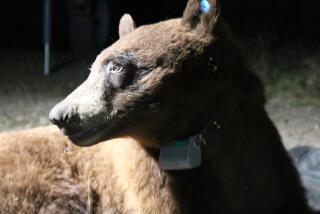Back to Nature
Three California condors were taken by helicopter to the Sespe wilderness on Tuesday in preparation for their release to the Ventura County back country next week.
The birds, an old matriarch called AC-8 and two juveniles, will spend the next few days in a small cave getting acquainted and acclimated to their new mountain environment.
The young ones were reared in captivity, and the older female once soared over the Sespe before being captured as part of a condor-recovery program 14 years ago.
It will be the first time in nearly a decade the gigantic, soaring birds have been released in the county. Release of captive birds in a special condor sanctuary above Fillmore ceased in 1992 after five birds died crashing into power lines and in other hapless encounters with civilization.
“If this works, and we don’t have problems with these birds this time, it means we will be putting a pretty big part of wildlife history back into Ventura County,” said John Brooks, spokesman for the U.S. Fish and Wildlife Service.
Biologists are more optimistic this time. The egg-producing days for AC-8 are over, so wildlife experts believe she will be a mentor for the younger birds and adolescent condors now soaring above Los Padres National Forest.
AC-8--as in Adult Condor No. 8--will become the first mature condor returned to the wild from the original group of 27 birds captured in 1986 in a risky gamble to save the species from extinction.
AC-8 proved to be a fertile breeder, producing nine chicks that have survived over the years. With her help, the population of those giant birds in California and Arizona has risen from 27 to 155, including the 56 known to be living in the wild.
She was given a warm goodbye Tuesday at the Los Angeles Zoo, where she had been housed most recently. Dozens of schoolchildren waved as she was being swept into the sky, carried aloft not by her 9-foot wingspan but in a cage within a helicopter.
When AC-8 is released next week in Sespe Condor Sanctuary, wildlife officials say she must relearn the art of soaring in the thermal air currents far above Southern California’s mountains and deserts.
“‘She’ll have to get in shape,” said Greg Austin, a field biologist with the U.S. Fish and Wildlife Service. “But we suspect she’ll be able to get in the air pretty fast.”
One wing of the 17-pound condor has been fitted with a small electronic transmitter, which will be linked to a satellite and allow scientists to monitor her movements. Officials of the California Condor Recovery Team, established in the mid-1970s, say this monitor is a state-of-the-art innovation.
The condor, whose age is uncertain, spent most of her captivity at the San Diego Wild Animal Park. Since her move to the Los Angeles Zoo six months ago, the older bird has been getting to know two younger condors in the specially constructed 100-foot-long, 60-foot-high condor flight pen, known as the “condorminium.”
Once in the wild, it is hoped the older condor will pass survival skills on to younger ones and show them around the 200-mile hunting range over which she once soared.
At the zoo, the birds were put through “power pole aversion therapy.” Power poles have caused the death of a number of condors living in the wild. A realistic looking power pole was set up in the pen and the birds get a light shock if they land on it. Once shocked, they learn to stay away.
Even though some of the big birds have been shot or died from other causes after being released, most have flourished, according to zoo workers.
Michael Clark, a condor keeper at the zoo, said releasing AC-8 back to the wild keeps a promise that members of the condor team made when they rounded up the 27 original condors in what at the time was a controversial move. One fear was that the round-up would destroy the passing of knowledge from generation to generation about the best roosts and feeding areas.
“We have reason to believe she’ll do fine,” said Clark of the prized condor. “She is a very tough bird. Very healthy. These birds don’t forget anything. We suspect she will almost immediately recognize some of the landmarks. She’ll get back to business as usual very quickly.”
Times staff writer Gary Polakovic contributed to this story.
More to Read
Sign up for Essential California
The most important California stories and recommendations in your inbox every morning.
You may occasionally receive promotional content from the Los Angeles Times.










